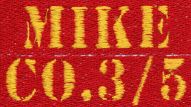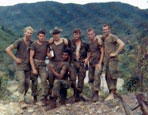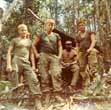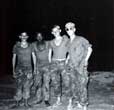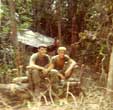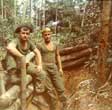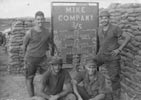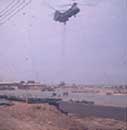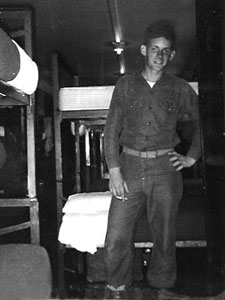Operation
TAYLOR COMMON This is NOT an official USMC combat operations page, but my personal attempt to recover as much information as we can about the operations 3rd Battalion, 5th Marines M Co. participated on in Vietnam. Operation TAYLOR COMMON cost these Marines dearly. Information is from remembrances/pics and other related info sent in by Marines and FMF Corpsmen, please don't copy or use their information in any way without express permission. 3rd Battalion, 5th Marines participated in Operation TAYLOR COMMON in the western part of Thoung Duc until it terminated on 8 March 1969, after which they conducted offensive operations in the Fifth Marines southern AO and provided for the security of the An Hoa Combat Base in the Quang Nam Province of RVN. They operated in both the mountainous jungle canopy of Base Area 112, and the low flat area of the An Hoa Basin during the month. The first of March, the Battalion was in Base Area 112 with two companies in the vicinity of FSB Maxwell, and two companies with the Battalion Command Post in the vicinity of FSB Tomahawk. With the return to An Hoa of all companies during the period four through seven March, Operation TAYLOR COMMON was terminated. On 7 March, the Battalion commenced operations in the vicinity of the An Hoa Combat Base. In addition, for various periods of time during the month one or two companies participated in manning the defense sector of An Hoa Combat Base, and providing security to the southern portion of Liberty Road. The Battalion area of operations included the southern portion of the 5th Marines area. On 26 March, it was expanded to include the Phu Nahn area. (Information from 3rd. Bn. 5th Marines Command Chronology for March 1969). 3rd
Battalion, 5th Marines Spot Report Journal, March 1969 (click images to enlarge)
Pictures and information below was submitted by M Co. 3/5 Marines and their families and friends. Click on images to enlarge
"March 1969 after surviving 103 days in the bush during Operation TAYLOR COMMON. There weren't many Marines left from 1st Platoon after that operation." Paul O'Connell, M/3/5 1st plt.
Pictured standing from L-R: Ron Christianson (Millville, CA), Les Thompson (Orlando, FL), Richard Reed (Knoxville, IA), Mike Alden (Manly, IA), David Johnston (Pinkerting, Ohio), Simpson, and kneeling, Luther Maxwell.
"No one, except the dog handler was medevaced-and the dog. Could not get choppers in-too much canopy and enemy ground fire. Most fortunate to get the dog handler and his dog out-that was not easy. Quite a delay for the Company-3 hrs. or so. When "M" Co.made its advance up the side of the leading hill to Hill 332, we were ambushed. Rather than proceed on, because of our delay, the decision was made to set up a perimeter for the night right where the company was stopped. Word came down to get 7 Marines and recon the trail north of our perimeter. About 70 to 80 meters up the trail we were ambushed by entrenched enemy forces.This was the beginning of the end for Operation TAYLOR COMMON, and the start of the battle on Hill 332."~Mike Alden
***************************** Michael
McFerrin HILL
332 On March 3, 1969, Mike Company was halfway up the ridge heading to Hill 332 when an NVA ambush was encountered. The contact with the enemy was brief and violent. The attackers withdrew shortly under withering return fire from the various portions of the column that were able to fire over or around the fallen point Marine. The scout dog handler was severely wounded and the scout dog was not approachable by anybody except his handler. This caused quite a delay as several Marines using shirts wrapped around their arms subdued the dog so that the wounded handler could be reached. The muzzle was recovered from the wounded Marine’s gear and wrestled on to the dog. With the leash and muzzle firmly in place, the dog was minimally responsive to being handled by somebody new and was secured while a corpsman treated his handler. The incident caused us to be delayed for almost three hours. Constant attention was required to keep the wounded man alive. CPR was applied multiple times as he began to succumb. The "canopy" of tree layers above us was so thick that it was difficult to find a place where it was thin enough to at least get a sling through to remove the casualty and his dog. A place was finally found and a medevac was called. It was so late in the day that the Company Commander opted to set us into a perimeter there where the medevac was coming. While we waited for the medevac, a squad-size patrol was sent further up the trail to recon the area. This patrol ran into a heavily entrenched force some 70 meters further up the ridge. The squad left 3 men killed in action directly in front of a well camouflaged bunker when they were finally able to withdraw. The remaining hours of daylight were spent to recover these bodies and simultaneously dealing with two and three man enemy probe attacks that were slipping through the underbrush to hit the backside of our perimeter. Two bodies were recovered from the ambush site and there were three separate unsuccessful attempts to get the last one before shutting down for the very dark night that comes to the forest. 4 March 1969 On March 4th, we expected the enemy probes to stop during daylight hours but they did not. They launched them every 3 or 4 hours in the daylight. In the meantime, the platoon that had lost the men the day before continued to assault the enemy bunkers in attempts to recover the last body. Many more casualties were taken. The enemy’s movements around our perimeter were increasing. Artillery fire, helicopters, Phantom jets, and "Spooky" AC-130 planes with large rapid fire machine guns began to be employed, firing in a circle around us to try and keep the enemy back as well as to “soften” the defense that kept us from recovering the body. This support continued non-stop through the night, and into the following day. 5 March 1969 Early on March 5th, all platoons began to assist in the attempts to recover the last body but after a couple of attempts our cumulative casualty total for the two days had risen to the point that the Battalion Commander ordered us to get out of there. By that time though, there were not enough of us left to carry all of the dead and wounded and still fight our way out. The Battalion Commander ordered another Marine Company to come to our assistance. They were moved to a point where they would be ready to fight their way in on the following day. The Company Commander wanted to try at least one more time to recover the Marine’s body. It had already been proven that this would have only a slim chance for success so this time he asked for a volunteer to make a final attempt to get the body. When the call for a volunteer was brought to me, I cringed. I moved through my platoon area stopping at each position to advise them of the request for a volunteer. There were no takers. At least not immediate ones. Maybe some were thinking about it. By the time I returned to my platoon command post, I heard that Sergeant Thompson had already volunteered. I remember shaking my head in an “I should have known” way, plopping down on the edge of my foxhole, and considering the situation. I felt very close to Sergeant Thompson for several reasons. The main reason was that any Marine in the company who had been there long enough to have experienced and survived the battles fought up until mid-November was truly a veteran in good standing. There were not that many of us. All were considered “pillars of experience” amongst the majority “new people” in the company that helped guarantee the unit’s survival in these worst case scenarios. Regardless of their rank, these men were the real anchors of any unit in battle in Vietnam. Thompson was certainly one of these. Another of the reasons that I felt an affinity was that he was not only an experienced bush Marine but he was now also a Platoon Sergeant. Our bush careers were almost parallel. We had both moved up in our different platoons at almost the same rate. From the time that I had first talked with him on September 11, 1968, I had regular communication with him during those times in the bush when we were in a position to do so. I was comfortable in a night defensive perimeter with his platoon having a third of the responsibility for our survival even though his platoon also often suffered from the “too many new guys” syndrome. He, as others and I had to do, balanced the lines at night to deal with this potentially disastrous shortage of experience in our platoons. And it hadn’t escaped my notice that Thompson had become a very serious and a very dedicated Marine since that day of the previous year that he crossed the paddy and attacked that NVA bunker. We experienced the fellowship of being survivors of many bad battles and the mutual respect earned by engineering increasingly larger portions of the unit’s survival that required more and more of our dependence on each other. But above all of that, I truly liked what he had become. I was not a “lifer” in any sense of the word nor did have any real awe or respect for rank alone or real lifers. That was because I had found out what a “professional” was. I knew that Les Thompson would become a lifer. But long before that time and far more important was that Les Thompson had become a professional Marine. That is how I saw him. I became less and less comfortable with Sergeant Thompson taking this risk. Whether he was successful or not in recovering this body, Mike Company still had to get off this mountain to a place where we could safely get the wounded, the dead, and the rest of us out. The survival of the company was at stake here and he could be a vital portion of that. My Platoon Commander came from the Company Command Post and gave me the assignment to take my platoon out to the right side of the enemy perimeter and start an assault to distract them while Sergeant Thompson got into position to recover the body. There was only a few minutes left. I got my platoon up and moving over to the side of our perimeter where we would exit then looked for Les. I didn’t have to go far. There he was, sitting on a felled tree and camouflaging himself. I sat on the log facing him as he applied something to face and neck. Mud, ashes, and I think he had a stick of camouflage paint because I wondered where he got it. We had always used mud and ashes because for some reason we never had the real stuff. I talked with him about the value of what was being done and tried to slip right into his value to the company. He stopped me when he realized that I was trying to say that he shouldn’t go and said, “Well, if I don’t somebody else will have to.” I spent another 2 or 3 minutes trying to find logic or a way to present it to get him to “unvolunteer.” I realized that I was losing but my head and heart ached with the thought of losing him so I kept at it. Then a young Marine from his platoon walked up to us to tell Thompson that he was ready to go. This is when I found out that Les would not be by himself in the attempt. It was time to go. I let him know that I would give him all that I could on the flank assault, wished him luck and shook his hand. As I walked away I began to seize upon the new fact of the other person being out there. This could certainly improve the chances of success. I used this thought to buoy myself to a positive hopeful level. It took about 10 minutes for me to brief the platoon and then move out of the perimeter to a starting point for our covering assault. As I walked the width of the assault line to get a view of what everybody faced, I was shocked. I could not get more than eight men across because of the terrain and even the last two or three were in jeopardy because they would not be able to keep up with the others. And I couldn’t even place myself where Thompson would be visible so that I could accurately direct fire. I radioed back to advise the Platoon and Company Commanders of the situation secretly hoping it might change what was happening. Instead, I was told to adapt the assault to the terrain, pick the correct tree to keep all of our fire in front of, and completely cease firing when I was radioed to do so. We started our assault and it immediately fell apart. The ground on the 50 to 70 degree slope was loose which caused everybody to slip backwards. This turned our eight man front into a 5 man front instantly. I yelled lots of orders but after about five forward steps we found that we could only move forward if we used one hand on a tree to pull ourselves up and forward while firing the rifle with the other. Then the enemy began returning fire and rolling hand grenades down on us. I had actually moved up to become part of the assault to increase our firepower when the other three men fell back so the radio man had to yell to me when the cease fire order came. I issued it and prayed. It was no more than 10 seconds later that I heard the gunfire that wasn’t ours. I knew but didn’t want to. When the radioman indicated I needed to come and get the handset to personally speak to the Platoon Commander, I could not avoid it. (Remembrance:I do not know who or what Les Thompson was before he came to the Marine Corps but I do know what he had become. America and the Marine Corps lost a man who was one of their finest. I could only quietly cry for such a man.) Michael McFerrin, Third Platoon, Mike Company
5
March 1969 I led the Force Recon platoon (Special Ops) that retrieved Sgt. Leslie Thompson and two other Marines' bodies, Dennis Merryman and Ronald Christianson. On two other occasions, prior to our insertion by ladder (150 feet attached to the bottom of a CH-46 helicopter), there were attempts at getting the bodies out, but they were shot out of the LZ by enemy fire. After much bombing, defoliates (Agent Orange), and the dropping of CS Crystals ( a very potent tear gas) on the area, my platoon took off at 1030 hrs. on 4 April '69 to fly the 20 to 25 minutes to the area in order to get the Marines. Five of those troops retrieved the bodies off Hill 332. That is a very young Ed Browder in the right rear with the "butter bar' on the cover. Three troops from Mike went with us, Capt. Burns, CO; Lankalais; and another whose name escapes me now.
When we got to Hill 332, we were inserted by ladder into a blown out area through the canopy. Three Marines were with our platoon (usually 6 men) from Mike Company: Capt. Burns, Company Commander; LCpl. Westphal; and Pfc. Lankalis. The "Mike" Marines took us to the area. We found the bodies very close together, no mutilation (they were where they had first fallen) with their weapons intact, including an M-79 grenade launcher and its ammo bag full of "blooper" rounds. The enemy had been regular NVA. Bodies untouched and gear left. I'm sure they (NVA) had to clear the area fast as return fire, artillery strikes and air strikes came to bear, so that Mike Company could safely clear the area. Semper Fi~Ed Browder ****************************************
Operation
TAYLOR COMMON January 11, 1969 Pfc.
Harold J. Slingerland, Jr. January 15, 1969 Pfc.
Gary Lee Heeman March 3, 1969 LCpl.
Joseph Lloyd Freeman, Jr.
Cpl.
David Allen Johnston LCpl.
Ronald F. Christianson March 5, 1969
LCpl.
Dennis Gary Merryman Sgt.
Leslie Dale Thompson March 6, 1969 Pfc.
Ronald De Vere Duntz H&S and Mike 3/5 Wall of Honor *************** [Home][Table
of Contents] [What's
New] [USMC Picture
Pages ] [FMF
Corpsmen] |












